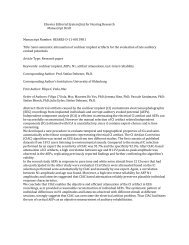An analytic Green's function for a lined circular duct containing ...
An analytic Green's function for a lined circular duct containing ...
An analytic Green's function for a lined circular duct containing ...
You also want an ePaper? Increase the reach of your titles
YUMPU automatically turns print PDFs into web optimized ePapers that Google loves.
ARTICLE IN PRESS<br />
azimuthal mode (modulus and phase) <strong>for</strong> a short distance to the left and right of the source plane, as well as<br />
the total Green’s <strong>function</strong>. Although these fields are continuous at the source, this does not mean that we have<br />
a converged value at the source plane (maybe near the source). On the contrary, it can be seen (Fig. 6, left) that<br />
none of the azimuthal mode amplitudes converge to a finite limit, indeed because the field diverges at the<br />
source position r ¼ r0. We cannot demonstrate this as easily with the numerical Green’s <strong>function</strong>, as we have<br />
to invert, <strong>for</strong> each azimuthal mode number, a 2N 2N matrix where N is the number of radial modes. As we<br />
increase N much above 70, depending on the azimuthal mode number, the matrix appears to become ill<br />
conditioned and we can no longer solve <strong>for</strong> the numerical mode amplitudes. However, below that limit the rate<br />
of convergence appears to be similar to that of the <strong>analytic</strong>al Green’s <strong>function</strong>.<br />
For the flow case, the picture changes in some ways. In particular, we lose the left/right symmetry <strong>for</strong> the<br />
mode amplitudes, as is seen in Fig. 7. InFig. 8 we show the ratio of the <strong>analytic</strong>al and numerical mode<br />
amplitudes and it can be seen that the two results agree to better than 20% in modulus <strong>for</strong> the cut-on modes<br />
although these differences appear to grow without limit <strong>for</strong> the very well cut-off modes. As a result the axial<br />
variation of the <strong>analytic</strong>al and numerical Green’s <strong>function</strong> agree fairly well away from the source plane, but at<br />
and near the source plane there are significant differences, <strong>for</strong>eshadowing the not yet included surface wave<br />
(see below). In particular, Fig. 9 shows that, with this number of modes, the <strong>analytic</strong>al and numerical Green’s<br />
<strong>function</strong> have a large but different discontinuity at the source plane.<br />
|G −<br />
| Ratio<br />
mµ<br />
Phase Diff (G −<br />
), Radians<br />
mµ<br />
3<br />
2.5<br />
2<br />
1.5<br />
1<br />
0.5<br />
0.5<br />
0<br />
0 10 20 30 40 50 60<br />
1<br />
0<br />
−0.5<br />
S.W. Rienstra, B.J. Tester / Journal of Sound and Vibration 317 (2008) 994–1016 1007<br />
Radial Mode Number<br />
−1<br />
0 10 20 30 40 50 60<br />
Radial Mode Number<br />
|G +<br />
| Ratio<br />
mµ<br />
Phase Diff (G −+<br />
), Radians<br />
mµ<br />
3<br />
2.5<br />
2<br />
1.5<br />
1<br />
0.5<br />
−0.5<br />
0<br />
0 10 20 30 40 50 60<br />
1<br />
0.5<br />
0<br />
28<br />
24<br />
20<br />
16<br />
12<br />
8<br />
4<br />
0<br />
Radial Mode Number<br />
−1<br />
0 10 20 30 40 50 60<br />
Radial Mode Number<br />
Fig. 8. Ratio of numerical over <strong>analytic</strong> Green’s <strong>function</strong> mode amplitudes (o ¼ 28, M ¼ 0:45, Z1 ¼ 2:5, r0 ¼ 1; numerical based on 40<br />
cut-off modes). Modulus: left (a) and right (b) running modes. Phase: left (c) and right (d) running modes.
















